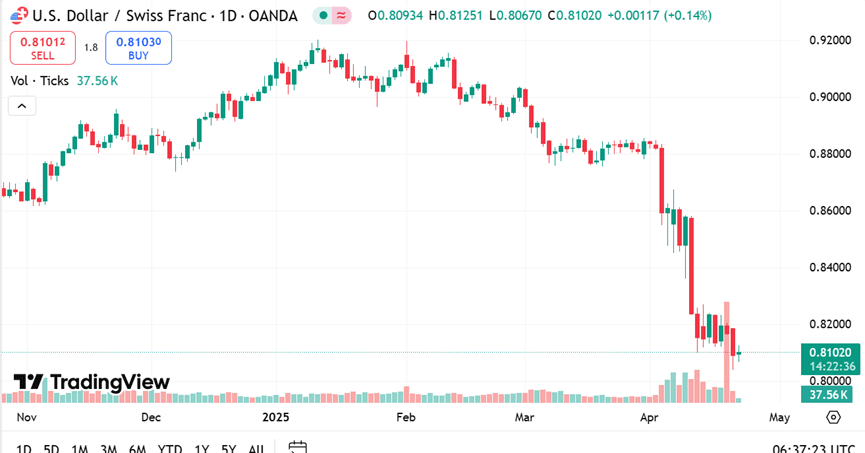Tuesday Apr 22 2025 08:14

6 min

Forex market today: the Forex market is experiencing significant fluctuations, particularly with the U.S. dollar reaching a three-year low against major currencies.
The USD/CHF pair is experiencing a decline for the third consecutive session, currently trading close to 0.8102 during Tuesday's Asian session. This downward trend is driven by the challenges facing the U.S. dollar amid rising economic and political uncertainty in the United States. As these concerns mount, the pair continues to feel pressure, reflecting the broader dynamics at play in the market.

Source: tradingview
This article explores the factors contributing to the dollar's weakness, the implications for the USD/CHF pair, and the broader context of the Forex market.
Economic Factors
The U.S. dollar has been under pressure due to a combination of economic factors. Concerns about inflation and the Federal Reserve's monetary policy have led to uncertainty in the markets. As inflation rates rise, the Fed's response to manage these rates becomes critical. Recent signals from the Fed regarding potential interest rate adjustments have created a ripple effect, influencing the dollar's value.
Trade and Geopolitical Tensions
Trade tensions and geopolitical issues have also played a role in the dollar's decline. Ongoing disputes and uncertainties surrounding international trade agreements have led to a cautious approach among market participants. This environment of uncertainty often results in a flight to currencies perceived as more stable, further weakening the dollar.
Market Sentiment
Market sentiment has shifted, with many participants adopting a more risk-averse stance. This shift is reflected in the increasing demand for currencies like the Swiss franc, which is often viewed as a more stable alternative during turbulent times. As a result, the dollar's value has been adversely affected, contributing to its recent lows.
Current Positioning
The USD/CHF pair is currently experiencing significant fluctuations, reflecting broader trends impacting the U.S. dollar. The Swiss franc has gained notable strength as market participants look for stability amid the dollar's volatility. This shift underscores the typical inverse relationship between the dollar and the franc, especially during periods of economic uncertainty. Factors such as inflation concerns and changing monetary policies have led many to reassess their positions in the currency market. As the dollar faces pressure, the franc is increasingly viewed as a more stable alternative.
This dynamic highlights the complexities of currency movements and the influence of market sentiment on exchange rates. The ongoing fluctuations in the USD/CHF pair serve as a barometer for broader economic conditions, indicating how shifts in confidence and risk appetite can impact currency valuations. As the landscape evolves, the interactions between these two currencies will continue to reflect underlying economic realities, making it essential for market participants to stay informed about the changing dynamics in the Forex market.
Although specific technical analysis is not the primary focus, the current positioning of the USD/CHF pair indicates potential challenges for the U.S. dollar. The recent lows reflect a bearish trend, suggesting ongoing difficulties for the dollar against the franc. Unless there are notable shifts in market sentiment or economic indicators, the dollar may continue to face headwinds in the near term. This situation highlights the need for market participants to remain vigilant as they navigate the evolving dynamics affecting currency movements and the broader economic landscape.
What Key Factors Drive the Swiss Franc?
The Swiss Franc (CHF) serves as Switzerland’s official currency and ranks among the top ten most traded currencies worldwide, with trading volumes that far exceed the size of the Swiss economy. Its value is influenced by various factors, including overall market sentiment, the economic health of Switzerland, and actions taken by the Swiss National Bank (SNB).
A few years ago, the Swiss Franc was pegged to the Euro, and the removal of this peg resulted in a sudden spike in the Franc’s value, causing significant market disruption. Although the peg is no longer in place, the fortunes of the CHF continue to be closely tied to those of the Euro, primarily due to the Swiss economy's strong dependence on the Eurozone.
Currency Movements
The decline of the U.S. dollar has not occurred in isolation. Other major currencies have also experienced fluctuations, with the euro and the British pound gaining ground against the dollar. This broader trend reflects a shift in market dynamics, where currencies perceived as more stable are attracting attention.
Impact on Global Trade
The weakening of the dollar has implications for global trade. A lower dollar can make U.S. exports more competitive, potentially benefiting American manufacturers. However, it can also lead to increased costs for imports, which may contribute to inflationary pressures domestically. This dual impact complicates the economic landscape and adds to the uncertainty surrounding the dollar's future trajectory.
Looking ahead, the outlook for the U.S. dollar remains uncertain. The Federal Reserve's actions in response to inflation and economic growth will be critical in determining the dollar's direction. Additionally, ongoing geopolitical tensions and trade negotiations will continue to influence market sentiment and currency movements.
The current state of the Forex market, characterized by the U.S. dollar's decline to a three-year low and the USD/CHF pair hovering near 0.8102, reflects a complex interplay of economic factors, market sentiment, and geopolitical dynamics. As participants navigate this landscape, the demand for currencies like the Swiss franc highlights the ongoing search for stability amid uncertainty. The future of the dollar will depend on various factors, including monetary policy decisions and global economic developments.
When considering shares, indices, forex (foreign exchange) and commodities for trading and price predictions, remember that trading CFDs involves a significant degree of risk and could result in capital loss.
Past performance is not indicative of any future results. This information is provided for informative purposes only and should not be construed to be investment advice.